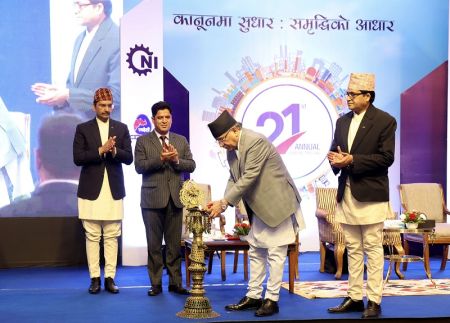.jpg)
Social entrepreneurship in Nepal is on the way of gaining its ground over the last few years. Despite its varied aspects and differences in its definition, entrepreneurs agree it to be a form of business that helps in promoting social causes and better changes in society. "Fortune at the bottom of the pyramid", a phrase coined by the late Indian academic CK Prahalad, has become popular among social entrepreneurs. But the question is: are we heading towards ensuring benefit to the bottom billions or not? In this issue, we focus on scope, opportunities and motivation for social entrepreneurs and the way forward.
--By Siromani Dhungana
Those at the 'bottom of the pyramid’ have been neglected since decades and it is time to change perceptions through which they are perceived. They should not be perceived only as recipients of aid.They are agents of development and they can be partner in entrepreneurship, says Catrin Frohlich, co-founder of Hidden Journeys who is involved in promotion of social entrepreneurship in Nepal for the last couple of years. She opines that acceptance of bottom billion as business partner opens avenue to set up social enterprises.
Social entrepreneurship embraces market-based approach as social enterprise is about innovation and making profit along with makingimpact on development of the society, she argues. It is not the rejection of profit but rather is about sharing of profit with target groups and there by helping them in enhancing their living standards, Frohlich adds.
Nepal needs to create jobs and job creation is not possible without enterprises. Social entrepreneurship is all about leading country towards prosperity through sustainable approaches.
.jpg) Scenario of Social Entrepreneurship
Scenario of Social Entrepreneurship A large number of population is reeling under acute poverty despite the fact that massive resources at the local level remain unused.In such a scenario, Nepal can be a very appropriate country for venturing into social enterprises.
However, it is again not an easy task to venture into social enterprises, especially in a country with relative absence of entrepreneurial aptitude. Social entrepreneurship is comparatively new phenomenon but it is gaining momentum, says Vidhan Rana of Biruwa Ventures. We have good understanding of the word social but less understanding of the word entrepreneurship, he opines. “Social entrepreneurshipis not about establishing NGOs and distributing aid money to people in need,” he says, adding, “Innovative ideas to venture into business is a must to start enterprise.”
Many people perceive the term social enterprise as a connotation of not-for-profit organization. The not-for-profit mantra is out-dated now, says Rana adding, “Make profit but involve the bottom billions in business and share the profit with them. This is the philosophy behind the concept of social entrepreneurship.” Social entrepreneurship has become a buzz word and Rana fears that this hypemight be misused by not genuine social enterprises.
This is a new domain and there is a corresponding dilemma at the policy level. While a debate on what is genuine social entrepreneurship has started, Sadhana Shrestha, executive director at TEWA and former Country Representative, in Nepal at Ashoka, accepts the prevalence of dilemma about the termamong businessmen also. While attempting to correct the prevailing notion that perceives both types of organizations synonymously, she says that NGOs and social enterprises are different. Nepal does not have laws specific to social entrepreneurship but it certainly has a category in the Company Act, which describes such companies as those that do not distribute profits (though they makes profits).
The most encouraging part in this is the increasing involvement of young generation. Youth led organizations such as Biruwa Ventures, Entrepreneurs for Nepal (E4N), Udhyami Nepali, Hidden Journeys and ChangeFusion Nepal have been working to promote entrepreneurship including that of social entrepreneurship.
.jpg) Fight Poverty with Profitability
Fight Poverty with Profitability “The Fortune at the Bottom of the Pyramid: Eradicating Poverty through Profits,” by C.K. Prahalad, professor of corporate strategy at the Ross School of Business of the University of Michigan is considered as a seminal work on social entrepreneurship. The concept of ‘The Fortune at the Bottom of the Pyramid’ provided new business models targeted at providing goods and services to the poorest people in the world. Prahalad’s concept seeks to solve global poverty by turning the bottom of the socioeconomic pyramid from victims of globalization into its beneficiaries through consumerism.
The book combined a pragmatic framework with inspirational case studies to show companies how they could develop innovative business models and find new profits by serving the world’s five billion poorest people at the bottom of the economic pyramid (or BOP).
Prof Prahalad was in favour of private-sector led social enterprises. Responding to a question “What are the big lessons learned since the book was first published?” by Triple Pundit, a new-media company for highly conscious business leaders, Prahalad said:
First, the thesis of the book that the private sector is an integral part of the poverty alleviation process is well accepted by multilaterals, aid agencies, many NGOs and large private sector firms as well. Second, there is now a growing belief that the bottom of the pyramid provides an opportunity for business to “do good and do well.” Third, we recognize that the BOP is more than micro-consumers. It also represents micro producers and micro investors who can be connected to national and global markets. And the BOP can also be the source of major innovations that affect us all. These ideas were in the original book but have been confirmed and amplified.
Reviewing the book, Bill Gates, Chairman and Chief Software Architect, Microsoft says: "C. K. Prahalad argues that companies must revolutionize how they do business in developing countries if both sides of that economic equation are to prosper. Drawing on a wealth of case studies, his compelling new book offers an intriguing blueprint for how to fight poverty with profitability." This book is considered a hallmark in introducing discourse and practices of private sector led social enterprises.
.jpg) Evolution of the Concept & Growing Concern
Evolution of the Concept & Growing Concern Many believe that business philanthropy and social involvement of business community is linked with long rooted concept of “Sewa Hi Paramo Dharma” [Social Service is the Ultimate Religion]. Historical evidences suggest that not all business leaders have been content in simply performing a commercial role in society. Numerous businesspersons, industrialists and entrepreneurs have made significant contributions to their local communities.
Earlier, there were notable efforts to engage business in society via charity or social welfare activities. These were mainly inspired by religious affiliation and cultural inspirations. From mid-1970s onwards general interest in corporate social responsibility grew and this is reflected in the involvement of Nepali corporate sector in CSR activities. This interest was consolidated in the 1980s. As part of the general redefinition of state functions in this period, the role of business in addressing social problems became more prominent. Such political and policy developments, it is argued, have made a significant contribution towards enhancing social roles of businesses.
Social Enterprises: Sustainable Approach of Development
Sadhana Shrestha, while stating that NGO workers should not be considered as social entrepreneurs, claims that social entrepreneurship should have some basic qualities: innovation, breakthrough ideas, sustainable and replicable model and system changing ideas.
Social entrepreneurs should give enough attention to the sustainability of their business and generally do not distribute dividend rather inject it in the business to ensure sustainability of the enterprise, she claims.
Social enterprises are businesses whose primary purpose is the common good. The main characteristics that distinguish a social enterprise from other types of businesses, non-profits and the government agencies is its sustainable approach, opines Mahabir Pun, the winner of the Ramon Magsaysay Award 2007 for his project that brought wireless Internet to rural Nepal.
Social enterprise directly addresses a difficult social need and serves the common good, either through its products and services or through the number of disadvantaged people it employs.
Challenges in Social Entrepreneurship
The social enterprise movement was connected mainly with non-profits that used business models and earned income strategies to pursue their mission in the early days of social entrepreneurship. The understanding has become clearer now. Enterprises, whose sole purpose is to make social impact, are now considered as social enterprises. The sector, however, is not out of challenges.
Identification of business model: Business is often linked with profit in Nepal. And even the image of non-profits is not very positive. In such a situation, building positive image for social enterprises is a challenging task, says Catrin Frohlich.
Capacity building: Building capacity of aspirant social entrepreneurs is another challenge for Nepal’s social entrepreneurial world. Capacity building initiatives should not be limited to launch of businesses, but should be continued when it comes at scaling up level, addsFrohlich.
Financing: A real social entrepreneurship is about innovation but traditional financing institutions do not always believe in innovative ideas and may deny lending money, opines Frohlich while pointing to the challenge of acquiring financial assistance for social enterprises.
Legal provision: Policy and regulatory frameworks have many grey areas. In such a context, it is feared that the word social entrepreneurship could be easily misused by non-profits and others institutions to gain undeserving reputation, says VidhanRana.
Opportunities
The concept of social entrepreneurship is an outcome of the realization that aid recipients cannot make tremendous progress in their life compared to entrepreneurs, says Vidhan Rana. In the same vein, Frohlich also opines that despite some good works, NGO-model of development is not always in favour of the bottom billion. Despite challenges, social entrepreneurship field in Nepal is recently witnessing positive trends and receiving new opportunities as it is the best model for optimum and sustainable use of resources.
If analysed from the perspective of national development, social entrepreneurship does not put the national economy at risk. It is a beautiful aspect of social entrepreneurship that while an individual takes all the risk of innovation, all members of the target community share the benefit.Similarly, social entrepreneurship is even more inclusiveforwomen entrepreneurs and adopting this approach can assist in making the entire development process more inclusive. Considering the present trend, it is obvious that in the coming years we’ll see social entrepreneurship woven into the very fabric of existing disciplines and become an integral lens through which we will understand all sectors and fields of study.
Corporate Houses for Social Cause
Corporate social responsibility (CSR) refers to a business practice that involves participating in initiatives that will have positive impact in the society. Generally, CSR activities are carried out using profit amount. CSR is a process with the aim to embrace responsibility for the company's actions and encourage a positive impact through its activities on the environment, consumers, employees and communities.
Though companies are not directly involved in social entrepreneurship, their involvement in social issues has been increasing in one or another form. In Nepal, many companies have been involved in many social activities such as Coke for water conservation, Unilever for hand washing promotion, Yeti Air tree plantation etc.
Involvement of business community in social activities is not new phenomenon. Some renowned business houses have been involved in some traditional CSR activities. Operation of eye hospital from Golchha and donation to Briddhashram (old age home) from some business families can be taken as examples to this end.
Further, some business houses have been involved in special CSR initiatives as annual events such as Asha Awards, Sports Tourism promotion, and health awareness program being carried out by Surya Nepal. There also are some companies such as NCELL that provide direct charity (e.g. school building, sukumbasi house roofing etc.) that is linked directly with their business promotion. Chaudhary Group has established a separate unit Yunus Centre to promote social entrepreneurship though it is yet to start work effectively.
Besides, recruitment of deaf staffs in the Nanglo restaurant can be taken as a good example of social entrepreneurship business. Dabur is also involved in social business as it provides help to farmers in herbal cultivation.
Future Outlook
Positive impact made by existing social enterprises on target communities and in making profit has triggered enthusiasm in aspiring entrepreneurs. Numbers of aspirant social entrepreneurs are increasing and their conviction show that they can make money and can do things differently in the entrepreneurial world. Social enterprises will prove that enterprises can be financially sustainable, even profitable.
.jpg)





















